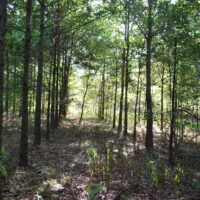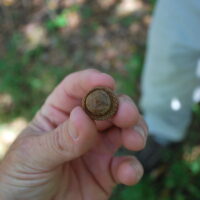 Purdue University - Extension - Forestry and Natural Resources
Purdue University - Extension - Forestry and Natural Resources
Got Nature? Blog
The Niehauses’ tree farm encompasses 182 acres in Perry and Dubois counties in southern Indiana. The land has been in their family since Dave Niehaus’s grandparents bought it soon after they married in 1909. Back then, only 100 or so acres of the property were forest; the remaining 80 acres comprised open land.
Niehaus’ grandparents built a house on the farm in 1918. In 1931, his grandfather died in a horse accident, leaving his grandmother to raise their nine children. Dave’s father, the oldest, was 19 at the time.
The children grew up and moved on, but Niehaus’s grandmother would continue living there for the remainder of her life. Young Dave grew up in Saint Meinrad, about six miles away. “I spent a lot of time up there, in the forest,” he says. “The fields then were in the Soil Bank program (now the Conservation Reserve Program) because about 40 acres of the open ground was in the flood plain, so they were used to losing their crops, and losing their soil down in the bottoms. In the CRP ground, once a year you’d have to mow all of that down. Dad had a little 8N Ford tractor with a side mower on there, and I mowed all that down and just spent time with Grandma up there.”
Niehaus’ older brother bought the property in 1969. When he decided to sell, Dave stepped up to purchase it in 2005. “It’s our roots,” he explains. “I didn’t want it divided up.”
Ten years earlier, he’d asked his brother for some land so he could try his hand at planting trees. Niehaus was an Army veteran and a carpenter; he didn’t know much about forestry, but he wanted to learn. He started in 1995 on a four-acre horse pasture with 16 5-gallon buckets of acorns he’d raked up in a city park. He rigged up a PVC pipe that dug a trench in the subsoil as he dropped the acorns through a funnel into the pipe, planting them in rows across the field.
The following spring, not a single white oak came up. “My brother just laughed and said, ‘You got a lot of fat mice running around up there,” Niehaus recalls.
The following fall, he enlisted the help of Dr. Jim Wichman with the Indiana Department of Natural Resources, Division of Forestry Nursery Section. Niehaus started one bucket of acorns in his garden, where he could better protect them from predators and mold. He experimented with coverage, noting that germination under peat moss far exceeded that of pine needles and dirt. He then hand-transplanted the seedlings to rows on the open land — a second, and more successful, try at growing a forest.
Over the next three years, Niehaus cultivated enough seedlings to hand plant the four acres. He expanded his sights.
One year he got 500 seedlings from the state nursery and in the course of planting them, credits his then 10-year-old daughter with an important lesson. “She said, ‘Dad, this is going to look funny when this grows up… When you go into a forest, the trees are spaced here and there. And these are all going to be in a row.’ And I said, ‘Andrea, you just got the vision.’ So that’s what it is now.”
After he bought the property in 2005, Niehaus signed on for a class at the Southern Indiana Purdue Agricultural Center in nearby Dubois, Indiana, Forest Management for the Private Woodland Owner. Extension Forester Ron Rathfon led the eight-week course.
“I wanted to know a little more about forestry,” Niehaus says. “I wanted to be a good steward of the property.”
Rathfon has been helping residents manage their woodlands for 30 years, along with the Purdue Forestry and Natural Resources Extension team and public and private resource professionals who offer classroom and field instruction. “Ron makes the class interesting, and he makes it fun,” Niehaus says.
His main takeaways from the course were in tree identification and forest biology. “If you want to manage your forest to get it to grow back to be oak trees, you have to be able to recognize the different species of trees at different ages,” Niehaus says.
For full article with additional photos view: Creating A Woodland Legacy: Dave and Carol Niehaus, Extension News and Stories
Resources
Hardwood Ecosystem Experiment – Wildlife Responses to Timber Harvesting, The Education Store, Purdue Extension resource center
Forest Improvement Handbook, The Education Store
Invasive plants: impact on environment and people, The Education Store
Managing Your Woods for White-Tailed Deer, The Education Store
Shrubs and Woody Vines of Indiana and the Midwest, The Education Store
Forest Management for Reptiles and Amphibians: A Technical Guide for the Midwest, The Education Store
Breeding Birds and Forest Management: the Hardwood Ecosystem Experiment and the Central Hardwoods Region, The Education Store
Native Trees of the Midwest, The Education Store
Investing in Indiana Woodlands, The Education Store
ID That Tree, Purdue Extension-Forestry & Natural Resources (FNR) YouTube playlist
Woodland Management Moment , Purdue Extension-FNR YouTube playlist
Subscribe: Deer, Forest Management, ID That Tree, Woodland Management Moment, Invasive Species and many other topic video playlists, Purdue Extension-Forestry and Natural Resources YouTube Channel
Ron Rathfon, Regional Extension Forester
Purdue University Department of Forestry and Natural Resources

Recent Posts
- 2024 Turkey Brood Count Wants your Observations – MyDNR
Posted: June 28, 2024 in Alert, Community Development, Wildlife - Case Study: Maple Tree Pests – Purdue Landscape Report
Posted: June 26, 2024 in Disease, Forests and Street Trees, Plants, Spiders, Urban Forestry, Wildlife, Woodlands - Woodland Management Moment: Oak Regeneration – Protecting Seedlings
Posted: June 24, 2024 in Forestry, Urban Forestry, Wildlife, Woodland Management Moment, Woodlands - Stories in the Bark – Patterns and Growth
Posted: June 22, 2024 in Forestry, Forests and Street Trees, Wildlife, Woodlands - Indiana’s Surprise Onion Plants Emerge
Posted: June 20, 2024 in Forestry, Forests and Street Trees, Plants, Urban Forestry, Wildlife, Woodlands - Celebrate Pollinator Week With Flowers of June Tour
Posted: in Forestry, Gardening, Wildlife - Leaf Curl and Blister Due to Wet Weather – Purdue Landscape Report
Posted: June 7, 2024 in Forestry, Forests and Street Trees, Urban Forestry, Wildlife - Learn How to Support Oak-Hickory Ecosystems
Posted: June 4, 2024 in Forestry, How To, Urban Forestry, Wildlife - Turtle Traffic: Save Turtles From Roads – My DNR
Posted: June 3, 2024 in How To, Wildlife - Spongy Moth in Spring Time – Purdue Landscape Report
Posted: in Alert, Forestry, Forests and Street Trees, How To, Invasive Insects, Urban Forestry
Archives
Categories
- Alert
- Aquaculture/Fish
- Aquatic/Aquaculture Resources
- Ask the Expert
- Christmas Trees
- Community Development
- Disease
- Drought
- Forestry
- Forests and Street Trees
- Gardening
- Got Nature for Kids
- Great Lakes
- How To
- Invasive Animal Species
- Invasive Insects
- Invasive Plant Species
- Land Use
- Natural Resource Planning
- Nature of Teaching
- Plants
- Podcasts
- Ponds
- Publication
- Safety
- Spiders
- Timber Marketing
- Uncategorized
- Urban Forestry
- Webinar
- Wildlife
- Wood Products/Manufacturing
- Woodland Management Moment
- Woodlands